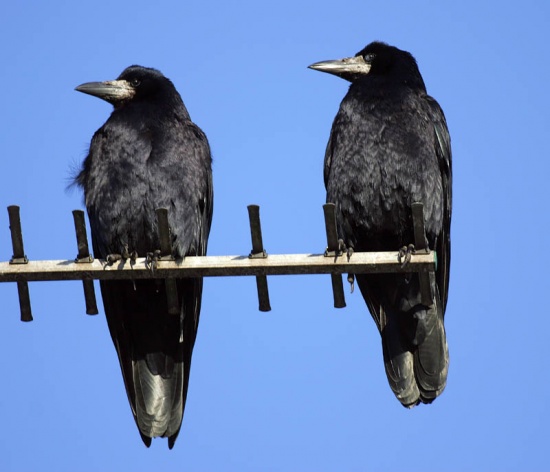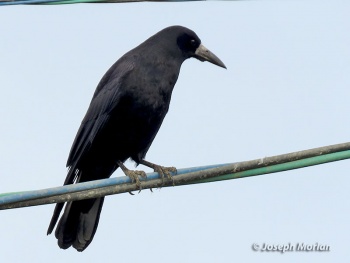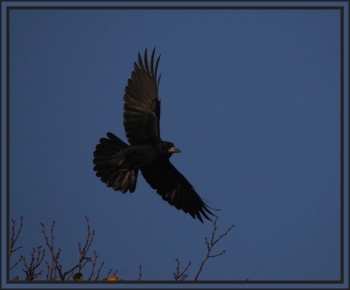
Photo © by christineredgate
Haverigg, Cumbria, UK, 2 December 2004
Alternative names: Eurasian Rook; Eastern Rook (pastinator)
- Corvus frugilegus
Identification
44–47 cm (17¼-18½ in)
Plumage is totally black, with a strong purple/violet gloss in the sun. Long, pointed pale bill leading to a black tip. Bare whitish face (in adult). Loose thigh feathers looking like 'baggy trousers'. Slightly peaked crown. Black legs. Rather rounded tail.
Juvenile is duller with a fully feathered face.
Similar Species
Carrion Crow has a much stouter all black bill, which is de-curved at the tip. Beware of confusion juvenile Rook and Carrion Crow. Common Raven is much larger and has a massive bill.
Variations
The smaller East Asian subspecies has its face and throat fully feathered unlike the nominate race in Europe.
Distribution
Found in Europe and Asia.
Widespread in Europe, reaching south Sweden, south Norway and west Finland in the north, northern Spain in the southwest. Mostly only found in the northern parts of Italy. Patchily found in Turkey, Armenia, Azerbaijan and Iran. In Russia east to Kazakhstan, Uzbekistan, Turkmenistan, Mongolia and most of China.
Reaches the Mediterranean in winter, also the Middle East, Iran, the Indian Subcontinent and south China,
An introduced population in New Zealand.
Very common to abundant in the west despite massive persecution as a pest bird. Pastinator in the east is much more localized and rarer.
Taxonomy
This is a polytypic species, consisting of two subspecies[1]:
- C. f. frugilegus from Europe east to central Siberia
- C. f. pastinator from central Siberia eastwards
Habitat
Open fields, or feeding in small groups along a roadside. They will come into town parks and villages.
Behaviour
Very gregarious throughout the year
Breeding

Photo © by Joseph Morlan
Izumi--Izumi Crane Observation Center, Kagoshima Prefecture, Japan, 18 February 2019
Nesting is in large colonies.
The nest is built high in a tree close to other nests. The nest is bulky and made from twigs bound together with earth, lined with moss, leaves, grass, wool, and hair. Previous years' nests may be renovated and reused.
Three to nine eggs are laid which are smooth, glossy and light blue, greenish-blue or green with dark spots. The eggs are about 40 mm long. The female incubates the eggs for 16-20 days. Both parents feed the young after they have hatched.
Diet
The diet includes insects, worms, carrion and seeds. They will visit bird tables for scraps and fruit.
Vocalisation
Call: "kaaa" (less harsh than Crow). <flashmp3>Corvus frugilegus (song).mp3</flashmp3>
References
- Clements, J. F., T. S. Schulenberg, M. J. Iliff, S. M. Billerman, T. A. Fredericks, J. A. Gerbracht, D. Lepage, B. L. Sullivan, and C. L. Wood. 2021. The eBird/Clements checklist of Birds of the World: v2021. Downloaded from https://www.birds.cornell.edu/clementschecklist/download/
- British Garden Birds
- Hayman, P. (2002)The New Birdwatcher's Pocket Guide to Britain and Europe. Mitchell Beazley. ISBN 1-85732-804-3
- Fitter, R. & S. Richmond (1966). Collins Pocket Guide to British Birds. London: Collins.
- Peterson, RT, G Mountfort and PAD Hollom. 1993. Collins Field Guide – Birds of Britain and Europe, 5th Revised edition. London: HarperCollins Publishers. ISBN 978-0002199001
- Del Hoyo, J, A Elliott, and D Christie, eds. 2009. Handbook of the Birds of the World. Volume 14: Bush-shrikes to Old World Sparrows. Barcelona: Lynx Edicions. ISBN 978-8496553507
- Brazil, M. (2018) Birds of Japan. Helm Field Guides
- Madge, S. & Burn, H. (1994) Crows and Jays: A Guide to the Crows, Jays and Magpies of the World. Houghton Mifflin, Boston.
- Madge, S. (2019). Rook (Corvus frugilegus). In: del Hoyo, J., Elliott, A., Sargatal, J., Christie, D.A. & de Juana, E. (eds.). Handbook of the Birds of the World Alive. Lynx Edicions, Barcelona. (retrieved from https://www.hbw.com/node/60784 on 2 May 2019).
Recommended Citation
- BirdForum Opus contributors. (2025) Rook. In: BirdForum, the forum for wild birds and birding. Retrieved 14 May 2025 from https://www.birdforum.net/opus/Rook
External Links
GSearch checked for 2020 platform.1





